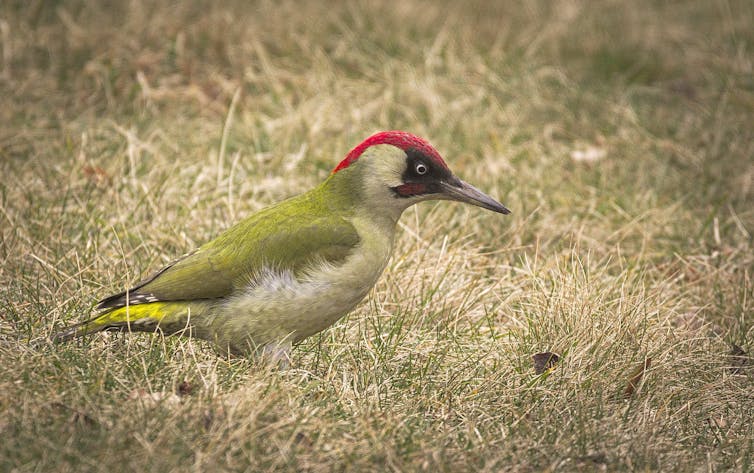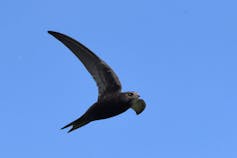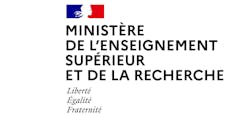Birds, collateral victims of agricultural intensification in Europe
For half a century, the scientific community has been sounding the alarm about the effects of pesticide use on human health and the disappearance of many species in agricultural environments. Rachel Carson's pioneering work in 1962 predicted "silent springs" caused by the decline of bird populations, collateral victims of pesticides through the poisoning of the environment and the disappearance of insects.
Vincent Devictor, University of Montpellier and Stanislas Rigal, ENS Lyon

The problem lies in an agricultural model based on ever-increasing industrialization in order to remain competitive internationally, which relies heavily on pesticides. This model is becoming increasingly dominant in France, where farms are becoming fewer in number (-40% since 2000) and larger in size (their average surface area has quadrupled since the 1960s).
Consequence: the agricultural area covered by farms that use large amounts of pesticides and fertilizers has continued to increase. As a result, only 17% of soil in Europe is not contaminated by pesticides. Since 2009, more than 300,000 hectares of agricultural land, often fertile, have disappeared under asphalt.
Beyond worrying observations and prophecies, is there tangible and unequivocal scientific evidence of the danger posed by this model of agricultural production to living organisms on a European scale?
The difficulty of conducting experiments on living organisms under real-world conditions
At first glance, experimentation seems like an ideal process. For example, feed sparrows seeds coated with pesticides, and they will be in poorer health. Fair enough. The process is very likely to work.
However, outside the laboratory, when variables are no longer directly controllable by the researcher, we enter a complex world where processes are caused by multiple intertwined factors. Under these conditions, how can we prove the effect of a particular factor on health or the environment?
[More than 85,000 readers trust The Conversation's newsletters to help them better understand the world's major issues. Subscribe today]
To overcome this difficulty, the scientific method can always rely on protocols and control variables. Thus, the effect of substances that are thought to be problematic and all other factors with a potential effect will not be manipulated experimentally, but studied statistically.
Because, while it is already somewhat brutal to force birds to eat pesticides, it is even more absurd to imagine that we can experiment with everything. Instead, we can check whether the use of increasing amounts of pesticides leads to a decline in the number of insects over time. In other words, we will approach the issue from an epidemiological perspective.
However, there is a catch. We can always assume that it is not pesticides that are to blame, but stress, air pollution, drought, or any other variable that may directly or indirectly influence the system under study.
We therefore needed to find a way to gain a clearer understanding of the situation. This is what we achieved with a team of 50 researchers in an open-access study published in May 2023. Our motivation was to determine whether one factor was more influential than others in explaining the decline in populations of many bird species in Europe, and if so, which one.
The unprecedented scale of the carnage in agricultural circles
First, it was necessary to quantify this decline. Thanks to the hard work of numerous volunteer ornithologists who repeated the same monitoring protocol every year in 28 European countries, an exceptional dataset was compiled covering the period from 1980 to 2016. This was an essential step: starting with the birds themselves in their habitats, not just an experiment on a few isolated individuals in a laboratory.
The study tracked 170 different species, with populations living in the wild and facing the full brunt of pollution, climate change, hunting practices, disturbance, and the risk of predation.
Far from limiting ourselves to agricultural environments, we looked at all habitats: forests, cities, mountains, open or closed environments, cultivated or uncultivated... In short, we examined the health of European birds without any filters.

The result? Birds lost a quarter of their abundance in Europe between 1980 and 2016, representing 800 million individuals over the period, or 20 million per year on average. This is a devastating loss, yet it comes as no surprise: birds have had to cope with profound changes in landscapes and lifestyles during the20thcentury.
Not all bird species are affected in the same way.
- For example, birds living in forest environments have lost 18% of their population;
- Those in urban areas, 25%,
- What is surprising, however, is the spectacular intensity of the decline in birds in agricultural plains: their numbers have fallen by 57%!
An unenviable record: this is one of the most dramatic declines ever recorded on this scale for living organisms.
Proving the link between agricultural intensification and bird decline
We needed to go further to understand what was causing this decline. Fortunately, we had the ideal data to test whether climate, habitat changes, and industrial agriculture could be held responsible.
Let's imagine for a moment: in a specific location, for example at the edge of a rapeseed field, one or more ornithologists have counted the number of birds each year using the same method. And, specifically for this year and this location, we also have data available on the expansion of intensive farming areas, changes in temperatures, the spread of artificial land use, and variations in forest cover.
It is this process, repeated at thousands of sites in the 28 countries studied over several decades, that has made it possible to build the most comprehensive and accurate database ever collected on wildlife monitoring in Europe.
This enabled us to establish a statistical link between bird populations and these multiple pressures, and to draw a second important conclusion: species decline coincides with the intensification of agricultural practices. In environments where industrial agriculture is more prevalent, regardless of climate and other conditions, bird populations decline more rapidly.
However, we were aware of another possible pitfall: that this link might be a mere coincidence attributable to chance. But this is not the case. Our analyses show that we are no longer in the realm of correlation, but of unequivocal linkage.
One final finding has allowed us to add another piece to our understanding of the situation: species that feed primarilyon insects, which have been eradicated by pesticides, are even more affected than other species.
Global warming and land development also to blame
Of course, the intensification of agricultural practices is not the only factor behind the declines observed. Climate change, particularly rising temperatures, is a second major pressure.

- Northern species, adapted to cold environments (such as the boreal chickadee, which has declined by 79%), are moving northward and seeing their populations decline sharply as temperatures rise.
- Conversely, other species adapted to warm environments (such as the Sardinian Warbler, whose population is increasing) may benefit.

The spread of artificial areas also comes at the expense of birds, which are unable to live in mineral and polluted environments and whose habitat is becoming fragmented.
Even species capable of nesting in urban areas are in decline (such as the Common Swift, whose populations have fallen by 17%), particularly due to the lack of available sites on modern buildings and the low abundance of insects in these environments.
Finally, the recent return of forest cover in Europe, often due to planting, is not enough to halt the decline of species dependent on natural forests.
Sowing doubt... and buying time?
These results should encourage us to drastically reduce our use of pesticides. But for defenders of agrochemicals, the level of scientific evidence is never enough.
A situation reminiscent of those surroundingasbestos, tobacco, or even the actions of fossil fuel producers to delay climate awareness.

All these industries have exploited the inherent difficulty of building scientific evidence in order to buy time, perpetuate doubt, and maintain their reputation and profits. Maintaining doubt has thus become a strategy.
To the point that manufacturers have now established themselves as the scientific benchmark for regulatory agencies, particularly in Europe.
It has become irresponsible to downplay the impact of the industrial agricultural model and its pesticides and to hide behind alleged biases, lack of perspective, or supposed absence of alternatives, which do in fact exist.
The widespread use of pesticides has a considerable social and economic cost, which is not reflected in prices as long as their use continues to be encouraged and subsidized. In terms of human health, their effects are increasingly well documented.
Everything should push us to change this production model. How can we be satisfied with describing agriculture that is incompatible with maintaining the health of humans and non-humans as "conventional"?
The necessary changes cannot rely solely on the goodwill of farmers who are entangled in an industrial model designed by and for agribusiness and embedded in an export model regulated by speculation or the search for the lowest price.
What is needed are transformative changes in the way we live in the world, produce, and consume. Political tools should be levers capable of initiating this transformation, rather than maintaining a model that is on its last legs "whatever the cost."
It is urgent that decision-makers at the European, national, and local levels finally face up to the devastation caused by certain outdated chemical farming practices that destroy life, trap farmers, and mock consumers.

Science and society feed off each other and benefit from dialogue. Research can draw on citizen participation, improve people's daily lives, and inform public decision-making. This is demonstrated by the articles published in our series "Science and society, a new dialogue," published with the support of the Ministry of Higher Education and Research.
Vincent Devictor, Director of Ecology Research, University of Montpellier and Stanislas Rigal, Postdoctoral researcher in conservation biology, ENS Lyon
This article is republished from The Conversation under a Creative Commons license. Readthe original article.